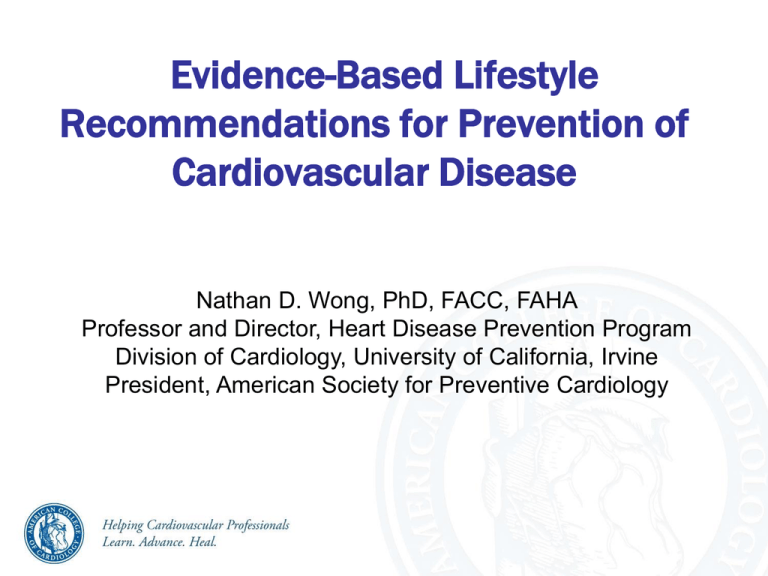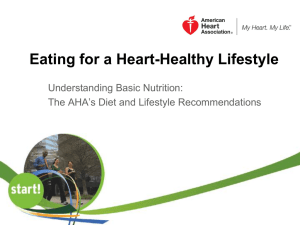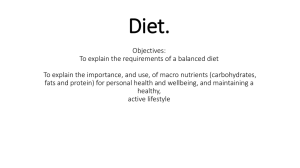
Evidence-Based Lifestyle
Recommendations for Prevention of
Cardiovascular Disease
Nathan D. Wong, PhD, FACC, FAHA
Professor and Director, Heart Disease Prevention Program
Division of Cardiology, University of California, Irvine
President, American Society for Preventive Cardiology
Global burden of Cardiovascular
disease
Nutrition, physical activity and NCD
prevention
• Up to 80% of heart disease,
stroke and type 2 diabetes and
over a third of the most common
cancers could be prevented by
eliminating obesity, unhealthy
diets and physical inactivity
• Call for commitments at the global
and national level to address these
risk factors including:
– Control food supply, food
information and marketing and
promotion of energy-dense,
nutrient-poor foods that are
high in saturated, trans-fat,
salt or refined sugars
The NCD Alliance: United by 4 risk factors
Modifiable causative risk factors
Non-communicable Diseases
Tobacco use
Unhealthy
diets
Physical
inactivity
Harmful use
of alcohol
Heart disease and
stroke
Diabetes
Cancer
Chronic lung
disease
Age-standardized prevalence estimates for poor, intermediate and ideal cardiovascular health
for each of the seven metrics of cardiovascular health in the AHA 2020 goals, among US adults
>20 years of age, NHANES 2005-2006 (baseline available data as of January 1, 2010).
©2010 American Heart Association, Inc. All rights reserved.
Roger VL et al. Published online in Circulation Dec. 15, 2010
Classification of Recommendations
and Levels of Evidence
*Data available from clinical trials or
registries about the usefulness/efficacy
in different subpopulations, such as
gender, age, history of diabetes,
history of prior myocardial infarction,
history of heart failure, and prior
aspirin use. A recommendation with
Level of Evidence B or C does not
imply that the recommendation is
weak. Many important clinical
questions addressed in the guidelines
do not lend themselves to clinical
trials. Even though randomized trials
are not available, there may be a very
clear clinical consensus that a
particular test or therapy is useful or
effective.
†In 2003, the ACC/AHA Task Force on
Practice Guidelines developed a list of
suggested phrases to use when
writing recommendations. All
guideline recommendations have been
written in full sentences that express a
complete thought, such that a
recommendation, even if separated
and presented apart from the rest of
the document (including headings
above sets of recommendations),
would still convey the full intent of the
recommendation. It is hoped that this
will increase readers’ comprehension
of the guidelines and will allow queries
at the individual recommendation
level.
Evidence for Current Cardiovascular Disease
Prevention Guidelines
Diet and Weight Management
Evidence and Guidelines
Weight Management Recommendations
Goals
Recommendations
Calculate BMI* and measure waist
circumference
BMI 18.5 to 24.9 kg/m2
Women: <35 inches
Men: <40 inches
Monitor response to treatment
I IIa IIb III
Start weight management and
physical activity as appropriate
10% weight reduction
within the 1st yr of Rx
*BMI is calculated as the weight in kilograms divided
by the body surface area in meters2
If BMI and/or waist circumference is
above goal, initiate caloric restriction
and increase caloric expenditure
BMI=Body mass index, Rx=Treatment
Smith SC Jr. et al. JACC 2006;47:2130-9
Body Mass Index:
Risk of Cardiovascular Disease
Hazard Ratio
Hemorrhagic
CVA
Ischemic
CVA
Ischemic Heart
Disease
4.0
4.0
4.0
2.0
2.0
2.0
1.0
1.0
1.0
0.5
0.5
0.5
16 20 24 28 32 36
16 20 24 28 32 36
16 20 24 28 32 36
Body Mass Index (kg/m2)*
CV=Cardiovascular
*BMI is calculated as the weight in kg divided by the BSA in meters2
Mhurchu N et al. Int J Epidemiol 2004;33:751-758
Abdominal Adiposity Is Associated
With Increased Risk of Diabetes
Relative Risk of Diabetes
25
P value for trend <0.001
20
15
10
5
0
<28 >28-29 30-31 32-33 34-35 36-37
Waist Circumference (in)
Carey VJ, et al. Am J Epidemiol. 1997;145:614-619
≥38
Diet Evidence:
Types of Treatment Programs
• Very low fat
– Ornish (Reversal diet and Prevention diet)
• Vegetarian with 10% calories from fat. No cooking oils,
avocados, nuts, and seeds. High fiber. No caloric restriction.
– Pritikin
• Very low-fat (primarily vegetarian) diet based on whole grains,
fruits, and vegetables
• Intermediate
– Sugar Busters
• 30% protein, 40% fat, 30% carbohydrates (low glycemic index)
– Zone
• 30% protein, 30% fat, 40% carbohydrates
Diet Evidence:
Types of Treatment Programs (Continued)
• Very low carbohydrate
– Atkins (Induction and Maintenance)
• 1st 2 weeks (<20 grams of carbohydrates/day with no high
glycemic foods).
• Then can add 5 grams of carbohydrates/day each week to
maximum of 90 grams of carbohydrates/day long term.
– South Beach (3 Phases)
• 1st phase (2 weeks) significantly restricts carbohydrates
• 2nd phase reintroduces low glycemic carbohydrates
• 3rd phase attempts to maintain weight
• Caloric restriction
– Weight watchers
• Assigns foods a point value and restricts the number of points
that can be consumed/day.
Diet Evidence:
Primary Prevention
160 overweight and obese patients randomized to the Atkins, Zone, Weight
Watchers, or Ornish diets for 1 year
Ornish
20/40*
Weight Watchers
26/40*
Zone
26/40*
Atkins
21/40*
0
3
Wt loss (lbs)
6
9
Weight loss is similar among diet programs, but hard to sustain because of
poor long-term compliance
*Ratio of individuals completing the study to those enrolled
Dansinger, ML et al. JAMA 2005;293:43-53
Lifestyle Heart Trial
• 41 male and female CHD patients
• Randomized to <10% fat diet, exercise and
meditation (Rx group) vs. Step 1 diet
• At one year 37% LDL-C reduction, 22%
weight loss, and 1.8 % regression in Rx group
vs 2.3% progression in control group
(quantitative coronary angiography)
• At 5 years 20% LDL-C reduction, 3.1%
regression in Rx group vs 11.8% progression
in control group (n=35)
Ornish et al. Lancet 1990; 336:129-133, and JAMA 1998; 280:2001-2007.
Evidence for Current Cardiovascular Disease
Prevention Guidelines
Diet, Cardiovascular Events,
and Guidelines
Diet Evidence:
Effect on Lipid Parameters and CRP
46 dyslipidemic patients randomized to a low fat diet, a low fat diet and
lovastatin (20 mg), or a dietary portfolio* for 4 weeks
Change from Baseline (%)
30
LDL-C
20
LDL-C:HDL-C
CRP
10
Low fat diet
0
Statin
-10
Dietary
portfolio*
-20
-30
-40
-50
0
2
Weeks
4
0
2
Weeks
4
0
2
4
Weeks
A diversified diet improves lipid parameters and CRP levels
*Enriched in plant sterols, soy protein, viscous fiber, and almonds
Jenkins DJ et al. JAMA 2003;290:502-10
Diet Evidence:
Effect on Blood Pressure
Dietary Approaches to Stop Hypertension (DASH) Group
459 hypertensive patients randomized to 1 of 3 diets for 8 weeks
Systolic blood
pressure
(mm Hg)
Diastolic blood
pressure
(mm Hg)
A diversified diet improves blood pressure
Appel LJ et al. NEJM 1997;336:1117-24
Pre-diabetic Conditions:
Benefit of Lifestyle Modification
Diabetes Prevention Program (DPP)
3,234 patients with elevated fasting and post-load glucose levels
Percent developing diabetes
randomized to placebo, metformin
(850 mg bid), or lifestyle modification* for
participants
3Allyears
Lifestyle
(n=1079, p<0.001 vs. Met , p<0.001 vs. Plac )
Placebo
Metformin (n=1073, p<0.001 vs. Plac)
Placebo (n=1082)
Cumulative incidence (%)
Incidence of DM (%)
40
40
Metformin
Lifestyle modification
30
30
20
20
10
10
00
0
0
0
1
1
22
3
3
44
Years from randomization
Years
Lifestyle modification reduces the risk of developing DM
*Includes 7% weight loss and at least 150 minutes of physical activity per week
Knowler WC et al. NEJM 2002;346:393-403.
Diabetes Prevention Program:
Reduction in Diabetes Incidence
Diet Evidence:
Benefits of Fruits and Vegetables
Nurses’ Health Study and Health Professional’s Follow-up Study
126,399 persons followed for 8-14 years to assess the relationship between
fruit and vegetable intake and adverse CV outcomes*
Increased fruit and vegetable intake reduces CV risk
*Includes nonfatal MI and fatal coronary heart disease
CV=Cardiovascular, MI=Myocardial infarction
Joshipura KJ, et al. 2001 Ann Intern Med134:1106-14
Diet Evidence:
Benefits of Whole Grains and Fiber
336,244 persons followed for 6-10 years to assess the relationship
between dietary fiber intake and adverse CV outcomes
RR=0.73, P<0.001
Increased dietary fiber intake reduces CV risk
CV=Cardiovascular, CHD=Coronary heart disease
Pereira MA et al. Arch Int Med 2004;164:370-76
Diet Evidence:
Primary Prevention
22,043 adults evaluated for adherence to a Mediterranean diet, with points
given for high consumption of vegetables, legumes, fruits, nuts, cereal, and fish
and points subtracted for high consumption of meat, poultry, and dairy
Variable
# of Deaths/
# of Participants
Fully Adjusted Hazard Ratio
(95% CI)
Death from any
cause
275/22,043
0.75 (0.64-0.87)
54/22,043
0.67 (0.47-0.94)
97/22,043
0.76 (0.59-0.98)
Death from
CHD
Death from
cancer
High adherence to a Mediterranean diet is associated with a reduction in death
Trichopoulou A, et al. NEJM 2003;348:2595-6
Diet Evidence:
Secondary Prevention
Lyon Diet Heart Study
605 patients following a MI randomized to a Mediterranean* or
Western** diet for 4 years
A Mediterranean diet reduces cardiovascular events
*High in polyunsaturated fat and fiber,
**High in saturated fat and low in fiber
De Lorgeril M et al. Circulation 1999;99:779-785
w-3 Fatty Acids Evidence:
Primary and Secondary Prevention
Japan Eicosapentaenoic acid Lipid Intervention
Study (JELIS)
18,645 patients with hypercholesterolemia randomized to EPA (1800 mg)
with a statin or a statin alone for 5 years
Years
w-3 fatty acids provide CV benefit, particularly in secondary prevention
CV=Cardiovascular, EPA=Eicosapentaenoic acid
*Composite of cardiac death, myocardial infarction, angina, PCI, or CABG
Yokoyama M et al. Lancet. 2007;369:1090-8
w-3 Fatty Acids Evidence:
Secondary Prevention
Gruppo Italiano per lo Studio della Sopravvivenza nell’Infarto miocardico (GISSIPrevenzione)
11,324 patients with a history of a MI randomized to w-3 polyunsaturated fatty acids [PUFA] (1
gram), vitamin E (300 mg), both or none for 3.5 years
w-3 fatty acids provide significant CV benefit after a MI
CV=Cardiovascular, MI=Myocardial infarction, NF=Non-fatal,
PUFA=Polyunsaturated fatty acids
GISSI Investigators. Lancet 1999;354:447-455
Adult Treatment Panel (ATP) III
Dietary Recommendations
Nutrient
Recommended Intake
Saturated fat*
<7% of total calories
Polyunsaturated fat
Up to 10% of total calories
Monounsaturated fat
Up to 20% of total calories
Total fat
25%–35% of total calories
Carbohydrate (esp. complex carbs)
Fiber
50%–60% of total calories
20–30 g/d
Protein
Cholesterol
~15% of total calories
<200 mg/d
*Trans fatty acids also raise LDL-C and should be kept at a low intake
Note: Regarding total calories, balance energy intake and expenditure to maintain desirable body weight.
Expert Panel on Detection, Evaluation, and Treatment of High Blood Cholesterol in Adults.
JAMA 2001;285:2486-97
American Heart Association (AHA) Nutrition Committee
Dietary Recommendations
Recommendations for Cardiovascular Disease Risk Reduction
• Balance calorie intake and physical activity to achieve or maintain a healthy
body weight
• Consume a diet rich in fruits and vegetables
• Consume whole-grain, high-fiber foods
• Consume fish, especially oily fish, at least twice a week
• Limit intake of saturated fat to <7%, trans fat to <1% of energy, and
cholesterol <300 mg/day by:
– Choosing lean mean and vegetable alternatives
– Choosing fat free (skim), 1% fat, and low-fat dairy products,
– Minimizing intake of partially hydrogenated fats
• Minimize intake of beverages and foods with added sugar
• Choose and prepare foods with little or no salt (AHA 2011 rec. <1500mg/d)
• If alcohol is consumed, do so in moderation
AHA Nutrition Committee. Circulation 2006;114:82-96
N-3 Fatty Acid Recommendation
American Dietetic Association 2007
For those without heart disease
• Two 3.5 oz svgs/wk of fatty fish are assoc with
30-40% reduced risk of death from cardiac
events.
Grade II Fair
N-3 Fatty Acids
American Dietetic Association 2007
For those with heart disease
• Approx 1g/d of DHA & EPA from fatty fish OR
supplement decreases the risk of death from
cardiac events.
Grade II Fair
N-3 Fatty Acid Recommendation
American Dietetic Association 2007
• Consume both marine & plant sources .
Fatty fish: two 3.5 oz serving/wk (salmon, herring,
sardines)
or
1.5 g ALA/day eg 1 TBS canola, 1/2 TBS ground
flax seeds.
Dietary Guidelines
Primary Prevention
I IIa IIb III
Women should consume a diet rich in fruits
and vegetables; choose whole-grain, high-fiber
foods; consume fish, especially oily fish,* at
least twice a week; limit intake of saturated
fat to <10% of energy, and if possible to <7%,
cholesterol to <300 mg/d, alcohol intake to no
more than 1 drink per day, and sodium intake
to <2.3 g/d (approximately 1 tsp salt).
Consumption of trans-fatty acids should be as
low as possible (eg, <1% of energy)
*Pregnant and lactating women should avoid eating fish potentially high in methylmercury
Mosca L et al. Circulation 2007;115:1481-501
Dietary Guidelines (Continued)
Secondary Prevention
I IIa IIb III
I IIa IIb III
Reduce intake of saturated fats (to <7% of
total calories), trans-fatty acids, and
cholesterol (to <200 mg per day).
Encouraging consumption of omega-3 fatty
acids in the form of fish or in capsule form (1
gram per day) for risk reduction may be
reasonable for patients with known CAD.
Smith SC Jr. et al. JACC 2006;47:2130-9
JNC VII Lifestyle Modifications for BP Control
Modification
Recommendation
Approximate SBP
Reduction Range
Maintain normal body weight
(BMI=18.5-24.9)
5-20 mmHg/10 kg weight
lost
Diet rich in fruits, vegetables, low fat
dairy and reduced in fat
8-14 mmHg
Restrict sodium
intake
<2.4 grams of sodium per day
2-8 mmHg
Physical activity
Regular aerobic exercise for at least 30
minutes on most days of the week
4-9 mmHg
Moderate alcohol
consumption
<2 drinks/day for men and <1 drink/day
for women
2-4 mmHg
Weight reduction
Adopt DASH
eating plan
BMI=Body mass index, SBP=Systolic blood pressure
Chobanian AV et al. JAMA. 2003;289:2560-2572
You Can Now Receive Medicare
Reimbursement for Nutrition Counseling
• The Centers for Medicare and Medicaid Services (CMS)
has issued a decision memorandum that will allow you to
be reimbursed for providing Medicare beneficiaries with
intensive behavioral therapy for obesity, defined as a
body mass index (BMI) ≥30.
• The agency suggests that more than 30% of the
Medicare population will likely qualify for the new benefit.
Intensive behavioral therapy for obesity
consists of the following:
• Screening for obesity in adults using BMI measurement
calculated by dividing weight in kilograms by the square
of height in meters (expressed in kg/m2)
• Dietary (nutritional) assessment
• Intensive behavioral counseling and behavioral therapy
to promote sustained weight loss through high intensity
interventions on diet and exercise
To be eligible for reimbursement, the counseling
should follow the “Five-A’s” format:
• Assess: Ask about/assess behavioral health risk(s) and factors
affecting choice of behavior change goals/methods.
• Advise: Give clear, specific, and personalized behavior change advice,
including information about personal health harms and benefits.
• Agree: Collaboratively select appropriate treatment goals and methods
based on the patient’s interest in and willingness to change the
behavior.
• Assist: Using behavior change techniques (self-help and/or
counseling), aid the patient in achieving agreed-upon goals by acquiring
the skills, confidence, and social/environmental supports for behavior
change, supplemented with adjunctive medical treatments when
appropriate.
• Arrange: Schedule follow-up contacts (in person or by telephone) to
provide ongoing assistance/support and to adjust the treatment plan as
needed, including referral to more intensive or specialized treatment.
• Providing that a Medicare beneficiary is obese, competent, and alert at
the time that counseling is provided and whose counseling is furnished by
a qualified primary care physician, or other primary care practitioner, and
in a primary care setting, CMS covers:
• One face-to-face visit every week for the first month
• One face-to-face visit every other week for months 2-6
• One face-to-face visit every month for months 7-12, if the beneficiary
meets the 3 kg weight loss requirement as discussed below
• At the six-month visit, you must reassess the patient’s obesity and
document the amount of weight lost. To be eligible for additional face-toface visits occurring once a month for an additional six months, patients
must have lost at least 3 kg (6.6 lbs) over the course of the first six
months of intensive therapy and should be documented in the record. For
patients who do not achieve this minimum weight loss during the first six
months of intensive therapy, a reassessment of their readiness to change
and BMI is appropriate after an additional six-month period.
• Source: Decision memo for intensive behavioral therapy for obesity
(CAG-00423N). Centers for Medicare & Medicaid Services Website.
https://www.cms.gov/medicare-coverage-database/details/nca-decisionmemo.aspx?NCAId=253 [1]. Published November 29, 2011. Accessed
November 30, 2011.
Evidence for Current Cardiovascular Disease
Prevention Guidelines
Physical Activity Evidence
and Guidelines
Physical Activity Recommendations
Goal: 30 minutes 7 days/week,
minimum 5 days/week
I IIa IIb III
I IIa IIb III
I IIa IIb III
Assess risk with a physical activity history and/or an
exercise test, to guide prescription
Encourage 30 to 60 minutes of moderate intensity
aerobic activity such as brisk walking, on most,
preferably all, days of the week, supplemented by an
increase in daily lifestyle activities
Advise medically supervised programs for high-risk
patients (e.g. recent acute coronary syndrome or
revascularization, HF)
RCT Trial Assessment of Pedometer
Interventions
N=277; 8 Trials
Pedometer increased steps by 2500/day
Bravata, DM et al. JAMA 2007; 298:2296-2304
Adverse Effects of Physical Inactivity
Physical Inactivity
Inflammation
Dyslipidemia
Age
Hypertension
Diabetes Mellitus
Smoking
Obesity
Hypercoagulability
Genetics
Atherosclerosis
Novel Risk Factors
Exercise Evidence:
Effect on Body Composition
173 sedentary, overweight (BMI >24 kg/m2) post-menopausal women
randomized to moderate intensity exercise vs. stretching for 1 year
Total Body Fat
Intra-abdominal Fat
Moderate exercise reduces total and intra-abdominal fat
Note: Minutes per week spent in moderate-intensity sports activity (low-active, 135
min/wk; intermediately active, 136-195 min/wk; and highly active, >195 min/wk)
Irwin ML et al. JAMA 2003;289:323-330
Exercise Evidence:
Effect on Lipid Parameters
Year and Lipid Level (mg/dL)
Baseline
1
3
5
Change from
Baseline
TC
Men
Women
214
239
213
223
210
209
196
193
8%
20%*
LDL-C
Men
Women
138
155
134
135
131
120
118
102
15%
34%*
HDL-C
Men
Women
37
47
40
50
41
55
39
56
5%
20%†
TG
Men
Women
200
188
197
190
199
174
202
171
NS
Lipids
*P=0.0001 for change in women vs men
†P=0.03 for change in women vs men
HDL-C=High density lipoprotein cholesterol, LDL-C=Low density
lipoprotein cholesterol, TG=Triglyceride
Warner JG et al. Circulation 1995;92:773-777
Exercise Evidence:
Effect on Lipid Parameters
Look AHEAD Trial
5,145 patients aged 45-74 years with type 2 DM and BMI 25 kg/m2 (27
kg/m2 if taking insulin) randomized to an intensive lifestyle intervention (ILI)
involving group and individual meetings to achieve and maintain weight loss
through decreased caloric intake and increased physical activity versus
diabetes support and education (DSE)
ILI
DSE
P value
LDL (mg/dL)
-5.2 ± 0.6
-5.7 ± 0.6
0.49
HDL (mg/dL)
3.4 ± 0.2
1.4 ± 0.1
<0.001
Triglycerides (mg/dL)
-30.3 ± 2.0
-14.6 ± 1.8
<0.001
% Metabolic Syndrome
-14.7 ± 0.8
-7.1 ± 0.7
<0.001
Intensive lifestyle intervention results in greater
improvements in lipid parameters
BMI=Body mass index, DM=Diabetes mellitus
Look AHEAD investigators. Diabetes Care 2007;30:1374-83
Exercise Evidence:
Effect on Obesity and Diabetes Mellitus (DM)
Nurse’s Health Study
Exercise reduces the incidence of obesity and DM
Hu FB et al. JAMA 2003;289:1785-91
Exercise Evidence:
Effect on Coronary Heart Disease Risk
Vigorous exercise*
Walking
P=0.008
P=0.004
Relative Risk of CHD
Relative Risk of CHD
Women’s Health Initiative Observational Study
1.0
0.8
0.6
0.4
0.2
0.0
1
2
3
4
5
1.0
0.8
0.6
0.4
0.2
0.0
1
2
3
4
5
Quintiles of activity (MET-hour/week**)
*Includes aerobics, aerobic dancing, jogging, tennis, and swimming laps
**Average active hours per week energy expenditure per activity
CHD=Coronary heart disease
Manson JE et al. NEJM 2002;347:716-25
Physical Activity:
Secondary Prevention
Observational study of self-reported physical activity in 772 men with CHD
Moderate exercise is associated with reduced mortality
CHD=Coronary heart disease, CVD=Cardiovascular disease
Wannamethee SG et al. Circulation 2000;102:1358-1363
Cardiac Rehabilitation:
Benefits Following a Myocardial Infarction (MI)
Effect of cardiac rehabilitation in randomized controlled trials following a MI
1.5
Pooled Odds Ratio
1.15
1
0.76
*
0.75
*
0.5
0
All Cause Death
CV Mortality
Nonfatal Recurrence
Cardiac rehabilitation reduces CV events after a MI
*p<0.0125
CV=Cardiovascular
Oldridge NB et al. JAMA 1988;260:945-950
Cardiac Rehabilitation:
Benefit of Secondary Prevention Programs
Meta-analysis of 63 randomized clinical trials evaluating cardiac
secondary prevention programs with or without exercise programs
All cause mortality
Recurrent myocardial infarction
Secondary prevention programs provide CV benefit
CV=Cardiovascular
Clark AM et al. Ann of Intern Med 2005;143:659-72
Evidence for Current Cardiovascular Disease
Prevention Guidelines
Cigarette Smoking Cessation
Evidence and Guidelines
NCDs, tobacco control and the FCTC
• Tobacco causes 1 in 6 of all NCD
deaths
• By 2015 the WHO estimates tobacco
will cause 6.4 million deaths a year
• Tobacco use impedes economic and
social development
• the WHO Framework Convention on
Tobacco Control (FCTC) is a set of
internationally negotiated, legally
binding, evidence-based tobacco
control measures –
implementation of the FCTC must be
accelerate
Tobacco Cessation Recommendations
Goals
Complete cessation
No environmental
tobacco smoke exposure
I IIa IIb III
Recommendations
Ask about tobacco use at every visit
In a clear, strong, and personalized manner, advise the
patient to stop smoking
Urge avoidance of exposure to second-hand smoke at
work and home
Assess patient’s willingness to quit smoking
Develop a plan for smoking cessation and arrange
follow-up
Provide counseling, pharmacologic therapy, and
referral to a formal cessation program
Smith SC Jr. et al. JACC 2006;47:2130-9
Cigarette Smoking Cessation Evidence:
Risk of Non-fatal Myocardial Infarction*
RR (95% Cl)
Study
Aberg, et al. 1983
0.67 (0.53-0.84)
Herlitz, et al. 1995
0.99 (0.42-2.33)
Johansson, et al. 1985
0.79 (0.46-1.37)
Perkins, et al. 1985
3.87 (0.81-18.37)
Sato, et al. 1992
0.10 (0.00-1.95)
Sparrow, et al. 1978
0.76 (0.37-1.58)
Vlietstra, et al. 1986
0.63 (0.51-0.78)
Voors, et al. 1996
0.54 (0.29-1.01)
0.1
Ceased smoking
1.0
Continued smoking
10
*Includes those with known coronary heart disease
Critchley JA et al. JAMA 2003;290:86-97
Tobacco Cessation Algorithm
Ask and document tobacco use status
Current User
Recent Quitter
(<6 months)
Advise Provide a strong, personalized message
Assess Readiness to quit in next 30 days
Ready
Not Ready
Assist: Negotiate plan
• STAR**
• Discuss pharmacotherapy
• Social support
• Provide educational materials
Prevent Relapse
• Congratulate successes
• Encourage
• Discuss benefits experienced by patient
• Address weight gain, negative mood, and
lack of support
Increase Motivation
• Relevance to personal situation
• Risks: short and long-term, environmental
• Rewards: potential benefits of quitting
• Roadblocks: identify barriers and solutions
• Repetition: repeat motivational intervention
• Reassess readiness to quit
**STAR
Arrange Follow-up to check plan or adjust meds
• Call right before and after quit date
• Weekly follow-up x 2 weeks, then monthly x 6 months
• Ask about difficulties (withdrawal, depressed mood)
• Build upon successes
• Seek commitment to stay tobacco-free
Set quit date
Tell family, friends, and coworkers
Anticipate challenges: withdrawal, breaks
Remove tobacco from the house, car etc.
The term
“Psychosocial”
broadly categorizes
factors which are:
• Psychologic – e.g, anxiety, depression
• Psychosocial – e.g., work stress,
discrimination, emotional support
• Social-structural – e.g., socioeconomic
status, social integration, neighborhood
effects
Screening for Psychosocial Risk:
AHA Science Advisory on Depression
(Lichtman J et al. Circulation 2008)
• The recommendations, which are endorsed by
the American Psychiatric Association, include:
– early and repeated screening for depression
in heart patients
– the use of two questions to screen patients –
if depression is suspected the remaining
questions are asked (9 questions total)
– coordinated follow-up for both heart disease
and depressive symptoms in patients who
have both.
From: Lichtman J et al., Circulation 2008
My Life Check Assessment
My Life Check Assessment
My Life Check Assessment
CONCLUSIONS
1) The increasing epidemic of obesity, diabetes, and
inadequate attainment of CVD prevention goals
necessitates improved efforts at therapeutic lifestyle
management.
2) Therapeutic lifestyle changes are a crucial and necessary
part of any cardiovascular risk reduction effort
3) Healthcare providers and facilities need to provide
patients with adequate access to lifestyle experts,
including registered dietitians, exercise specialists, and
stress management personnel to address lifestyleassociated CVD risk in patients
4) Recent legislation allowing for wider reimbursement for
lifestyle management, medical nutrition therapy in
particular, should be a motivation for healthcare providers
to ensure that these resources are available.








